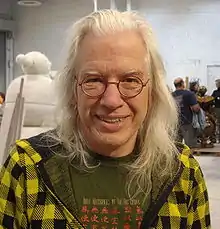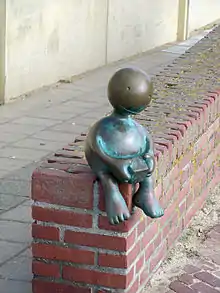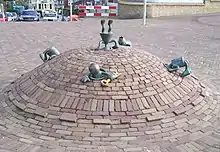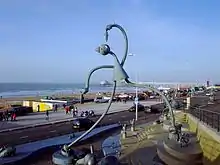Tom Otterness
Tom Otterness (born 1952) is an American sculptor best known as one of America's most prolific public artists.[1] Otterness's works adorn parks, plazas, subway stations, libraries, courthouses and museums around the world, notably in New York City's Rockefeller Park in Battery Park City[2] and Life Underground in the 14th Street – Eighth Avenue New York Subway station. He contributed a balloon (a giant upside-down Humpty Dumpty) to the Macy's Thanksgiving Day Parade.[3][4] In 1994 he was elected as a member of the National Academy Museum.[5]
Tom Otterness | |
|---|---|
 | |
| Born | 1952 |
| Nationality | American |
| Known for | Sculpture, Prints and Drawing |
| Movement | Colab |
His style is often described as cartoonish and cheerful, but also political.[6] His sculptures allude to sex, class, money and race.[4] These sculptures depict, among other things, huge pennies, pudgy characters in business suits with moneybag heads, helmeted workers holding giant tools, and an alligator crawling out from under a sewer cover. His aesthetic can be seen as a riff on capitalist realism.[7]
Known primarily as a public artist, Otterness has exhibited across the United States and internationally, including New York City, Indianapolis, Beverly Hills, The Hague, Munich, Paris, Valencia and Venice. His studio is located in Gowanus, Brooklyn.
Career
Otterness studied at the Art Students League of New York in 1970 and at the Independent Study Program of the Whitney Museum of American Art in 1973. He was an active member of the artists' group Colab (Collaborative Projects) from its inception in 1977, and was involved in punk visual art, notably exhibiting in the Punk Art Exhibition in Washington DC, 1978.[8]
Public artworks



Otterness began his career as a public art sculptor during his period with Colab and The Real Estate Show. He sold small, plaster figures for $4.99 at Artists Space in New York for the 1979 holiday season. His inspiration was the plaster replicas of Jesus and Elvis and Santería sculptures in botanica shops in the Bronx. "I thought "Oh, this is public art… This is something that everyone can afford and take home." The next year he made a series of small plaster proto monuments for Colab's famous 1980 The Times Square Show, which he helped organize.[4] This show featured inexpensive works by some 150 artists, including Kiki Smith, David Hammons and Jenny Holzer. He began showing with New York's Brooke Alexander Gallery soon after.[9]
Early installations in New York City and around the U.S.
Many of Otterness's public works are found in New York City. The Real World, located in Battery Park City, was commissioned in 1986 and installed in 1992. The sculpture ensemble is meant to represent the world outside the playground, "a broad social allegory on art and life, where the games of power and control are played out in miniature … an imaginative park with things to touch and stories to invent."[4][10] A familiar installation to New Yorkers is 2000's Life Underground, located in the 14th Street – Eighth Avenue NYC Subway station on the A, C, E, and L services.[11] The sculptural group consists of over 100 cast-bronze sculptures placed throughout platforms and stairways, and is one of the most popular public artworks in the subway system.[12] It took over 10 years to complete, and includes figures of a woman toting a nearly life-size subway token under her arm; a well-dressed fare jumper crawling under a metal gate; a homeless woman being rousted by the police; and two figures holding a cross-cut saw to cut into an I-beam that holds up a stairway.[13] The New York Times noted, "Mr. Otterness worked hard to find creative ways to place his sculpture, navigating around the rules of stations design."[14] There is also a smaller installation, titled The Marriage of Money and Real Estate (1996), in the East River off the west shore of Roosevelt Island.
One of Otterness's earliest public art works, The New World, was installed in 1991 for the Edward R. Roybal Federal Building in Los Angeles, California.[15] Otterness subsequently received Federal Courthouse commissions in Portland, Oregon (Law of Nature, 1997), Sacramento, California (Gold Rush, 1999) and Minneapolis, Minnesota (Rock Man, 1999).
Exhibitions
In 1987, Otterness exhibited his work The Tables at the Museum of Modern Art Projects show. White-collar workers, blue-collar workers, cops, radicals, captains of industry were displayed on four bronze picnic tables in the MoMA sculpture garden. The show traveled to the IVAM Centre Julio Gonzalez in Valencia, Spain; Portikus/Senckenbergmuseum in Frankfurt am Main; and Haags Gemeentemuseum in The Hague.
From September 20, 2004 to March 18, 2005, Tom Otterness on Broadway, his largest exhibition to date, featured 25 different works installed between Columbus Circle and 168th Street in Washington Heights, Manhattan. The project was sponsored by the City of New York Parks and Recreation Department, the Broadway Mall Association, and Marlborough Gallery, and traveled to three other cities—Indianapolis, Beverly Hills, and Grand Rapids, Michigan. The Grand Rapids exhibition featured more than 40 works across two miles of the city's downtown area and at Frederik Meijer Gardens & Sculpture Park.[16]
21st Century installations
Otterness's later installations increasingly responded to and interacted with their physical and natural sites and environments. His 1999 Feats of Strength is a collection of his iconic whimsical bronze figures representing faculty and students interacting with pieces of the natural sandstone at Western Washington University.[17] In a more urban setting (Claremont, California), Otterness's 2007 Matriculated Nature is embedded in the tiers of a fountain. Notably, it is one of his most intentionally thematic public artworks; Otterness's bronze figures are a series of vignettes to illustrate "the progression and evolution of knowledge and education, from early literacy to higher education,"[18] as they advance up the tiers of a fountain specially designed for the installation by architect Peter Tolkin.[18]
Films / Controversy
Otterness's work with Colab in independent punk art comprised a number of short films; on Colab's All Color News, these included Rats in Chinatown, filming rats at a Chinese deli,[19] and Golden Gloves boxing at Madison Square Garden (with John Ahearn), filming an amateur boxing match.[20]
His independent punk films featured real-life aggression and violence, most notoriously Dog Shot Film/Shot Dog Film, where he adopted a dog from an animal shelter in Golden, Colorado,[21] chained it to a stake, and filmed his hand shooting it dead. This was followed by four fight films, where Otterness, an amateur boxer, filmed his own Golden Gloves fights.[8] Shot Dog Film premiered at a Times Square screening room in early 1978, the film being shown in a loop, and viewers were flash-photographed when they left. The film was the only entry that was not accepted in the Punk Art Catalog, due to its offensive nature.[8] Otterness described it as follows:
The Dog Shot film … [is] about fucking someone... getting fucked by someone. That's what the fight films are about too. Running over someone; defeating someone; being defeated. They're the same thing those two films.[8]
You said earlier that when you showed Dog Shot Film at the screening room at 42nd Street that you wanted to hurt the viewers.
Yeah, I mean that whole night on 42nd Street, as best as I could do it, was the most aggressive way I could think of to show a film, the most damaging thing that I could do to the audience by showing a film. I hired a photographer with a camera so when people were leaving the theater, they were assaulted by a flash, attacked.[8]
Unfortunately, Shot Dog Film was inserted by an unknown person into the repeating programming cue on Manhattan Cable TV[21] instead of the normal cartoon programming for children. It was also shown on Christmas Eve[8] or Christmas Day,[21] 1978, and caused an instant outcry, leading to calls to prosecute Otterness. The film has continued to haunt Otterness, engendering continued controversy. Shot Dog Film was briefly mentioned as having "provoked a small scandal [in 1980]" in a 1997 New York Times article which dismissed it as "a seemingly uncharacteristic gesture that he has since declined to discuss."[22] It was brought back into the public conscience in 2004 by journalist Gary Indiana, who criticized Otterness for the killing.[23][24] Since then, Otterness has attracted criticism and protests for the 1977 film, apologized for his behavior, and lost a number of commissions from the continuing criticism.[25][26] Otterness's studio released a statement blaming his "anger at [himself] and the world" for the film.[26][27]
Thirty years ago when I was 25 years old, I made a film in which I shot a dog. It was an indefensible act that I am deeply sorry for. Many of us have experienced profound emotional turmoil and despair. Few have made the mistake I made. I hope people can find it in their hearts to forgive me.
— Tom Otterness, Brooklyn Daily Eagle, April 14, 2008[27]
In New York City in June 2011, the Battery Park City Authority, under Bill Thompson, rejected Otterness's lion sculptures for the area's new public library, after the sculptures were approved by 5-1 by Manhattan Community Board 1 under Chairperson Julie Menin.[28] The New York Public Library disavowed any involvement with the project, noting the donation of sculptures commissioned by a private donor had not been solicited by the NYPL.[29] Following the Battery Park City Authority's rejections, in 2011, there was renewed controversy over the film, with animal rights groups protesting the selection of Otterness for a major sculpture project at the Memorial Art Gallery of the University of Rochester.[30]
Also in 2011, the San Francisco Arts Commission terminated one of two contracts they had with Otterness.[31] He had been awarded a $750,000 contract in September 2011 for a piece in the new Central Subway project; the San Francisco Arts Commission claimed to be unaware of Shot Dog Film when they awarded the contract.[32] The mayor of San Francisco put the project on hold, calling the film "deeply disturbing."[33] In October 2013, Lincoln, Nebraska Mayor Chris Beutler decided against purchasing a $500,000 train sculpture from Otterness for the city's West Haymarket development, after residents objected to Shot Dog Film. Citing the unity brought about by the city's development, the mayor said, "...the artist's past behavior in this instance has created a level of division in the community that is simply not acceptable. Our feeling is that it is in the best interest of the city to discontinue the contract process."[34]
In September 2014, freelance artist Andrew Tider added three illegal sculptures to the "Life Underground" groupings in the subway station. They imitated the Otterness style, a blend of whimsy and biting commentary on corruption and greed, depicting a man pointing a gun at a dog, and a distant bystander.[35]
Personal life
Otterness practices tai chi, martial arts, and boxing since the mid-1960s. His studio has been photographed featuring a boxing bag.[36] Some early boxing fights in the 1970s were filmed as part of his no wave punk art period, and he has won prizes for his tai chi in the school of William C. C. Chen.[37] He lives with the American filmmaker Coleen Fitzgibbon on the Lower East Side in New York City and in Utica, Montana.
Further reading
- Inside the Artist's Studio, Princeton Architectural Press, 2015. (ISBN 978-1616893040)
- Alan W. Moore and Marc Miller (eds), ABC No Rio Dinero: The Story of a Lower East Side Art Gallery, Collaborative Projects, NY, 1985.
- Carlo McCormick, The Downtown Book: The New York Art Scene, 1974–1984, Princeton University Press, 2006
- Grace Glueck, The Downtown Scene", When It Was Still Dirty, The New York Times, January 13, 2006
- Carlo McCormick & Walter Robinson, (1982) Slouching Toward Avenue D, Art in America
- Julie Ault, Alternative Art, New York, 1965-1985, University of Minnesota Press, 2002.
- Grace Glueck, Up With People, Collaborative Projects exhibition review, The New York Times, January 6, 1984.
- David Little, Colab Takes a Piece, History Takes It Back: Collectivity and New York Alternative Spaces, Art Journal Vol.66, No. 1, Spring 2007, College Art Association, New York, pp. 60–74 (Article )
- Carlo McCormick, The Downtown Book: The New York Art Scene, 1974–1984, Princeton University Press, 2006.
- The Red Book, 1978 (NEA application document authored by Coleen Fitzgibbon, Andrea Callard and Ulli Rimkus) Andrea Callard Papers, The Downtown Collection, Fales Library, NYU.
References
- Carducci, Vince (April 2005). "Tom Otterness: Public Art and the Civic Ideal in the Postmodern Age". Sculpture Magazine. International Sculpture Center. Retrieved June 22, 2020.
- ""The Real World" Archived 2013-07-27 at the Wayback Machine" The Battery Park City Authority
- Vogel, Carol. "Two Major Collections Land at Christie's" The New York Times, Friday, September 23, 2005
- Sheets, Hilarie M., "Creeping Cats & Fish in Hats", Art News 105 (April 2006): 127-29
- "National Academicians. Otterness, Tom, NA 1994". Archived from the original on 2014-03-20.
- "The AI Interview: Tom Otterness," ArtInfo, October 2, 2006
- Carducci, Vince. "Tom Otterness: Public Art and the Civic Ideal in the Postmodern Age", Sculpture 24 (April 2005): 28-33]
- Miller, Marc H. "Punk Art Catalogue - Section III: X Magazine, Colab, Downtown Filmmakers". 98Bowery.
- Carducci, Vince. Tom Otterness: Public Art and the Civic Ideal in the Postmodern Age, Sculpture 24 (April 2005): 28-33
- Brenson, Michael (November 23, 1990). "Tom Otterness's Wicked World of Human and Beastly Folly". The New York Times.
- "Adler, Margot: "Subway Art: New York's Underground Treasures", Morning Edition. October 18, 2004.
- Chan, Sewell "Access to Art with a Metrocard Swipe", The New York Times, June 30, 2005
- Vince Carducci, "Tom Otterness: Public Art and the Civic Ideal in the Postmodern Age", Sculpture 24 (April 2005): pg 31 ]
- David W. Dunlap, "Train to the Museum? You're Already There", New York Times, January 21, 2007
- "Public Art in the Los Angeles Civic Center and Los Angeles Mall". www.publicartinla.com.
- Goldberg, Ira. "Speaking with Tom Otterness", Linea: Journal of the Art Students League of New York 10 (spring 2007): 4-7
- Paoli, Lauryn; Ford, Sarah (November 10, 2016). "Feats of Strength - Tom Otterness". Western Washington University - Public Art Collection. Retrieved June 22, 2020.
- Williamson, K. M. (June 22, 2020). ""Matriculated Nature" (2007) by Tom Otterness". Public Art in Public Places. Retrieved June 22, 2020.
- Colab 78-80 (1978-80): Rats in Chinatown runs 23:20–25:30
- Colab - All Color News – Golden Gloves boxing at Madison Square Garden runs 3:48–4:21
- The Breeze, February 29, 1980, "Artfile: ‘Shot Dog Film’", p. 11
- Cembalest, Robin (September 21, 1997). "ART; Public Sculpture the Public Likes. Really". The New York Times. Retrieved 22 March 2019.
- Indiana, Gary (December 6, 2004). "One Brief, Scuzzy Moment: Memories of the East Village Art Scene". New York Magazine. Archived from the original on February 13, 2007.
- Miller, Michael H. (October 4, 2011). "The Dog-Killing Woes of Tom Otterness". Observer.
The artist and critic Gary Indiana recalled the dog incident in an article in New York Magazine in 2004 about the New Museum’s “East Village USA” show. Mr. Otterness was included in the exhibition.
- "Millie turns 5 years old". The Sunflower. November 6, 2013.
- "Wichita State still plans to install piece made by artist who shot dog 30 years ago". Lawrence Journal-World. Associated Press. March 25, 2007.
- Frost, Mary (April 14, 2008). "Artist Apologizes for Decades-old Dog-Killing Incident". Brooklyn Daily Eagle. Archived from the original on 2008-06-26..
- Johnston, Garth (July 10, 2011). "Tom Otterness Statue Nixed Over 1977 Puppy Snuff Flick". Gothamist. Archived from the original on March 22, 2019. Retrieved March 22, 2019.
- Panero, James (May 11, 2011). "Opinion | Tom Otterness, dog killer: Cute sculptures disguise artist's cruel past". New York Daily News.
- Silverstein, Jason (October 6, 2011). "MAG receives protests, complaints over artist hire". Campus Times.
- Sabatini, Joshua (November 17, 2011). "Dog-killer artist loses SF contract, keeps second". San Francisco Examiner. Archived from the original on 2012-10-16.
- Sabatini, Joshua (September 16, 2011). "Sculptor who killed dog set to make San Francisco Central Subway art". San Francisco Examiner. Archived from the original on 2011-09-18.
- Lee, Stephanie (September 17, 2011). "S.F. subway sculpture on hold over artist misdeed". SFgate.com. Archived from the original on 2011-09-17.
- Hicks, Nancy (October 5, 2013). "Controversy kills 'Train Set' sculpture for West Haymarket". Lincoln Journal Star.
- Carlson, Jen (September 5, 2014). "Tom Otterness, Who Once Shot A Dog For Art, Mocked With New Guerilla Subway Sculpture". Gothamist. Archived from the original on 2014-10-22.
- Daily News, May 3, 1996, "Otterness enjoying his art", p. 36.
- "Archived Competition News". www.williamccchen.com.
External links
| External video | |
|---|---|